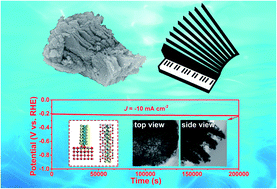Graphene-MoS2 vertically anchored on an MXene-derived accordion-like TiO2/C skeleton: an ultrastable HER catalyst†
Abstract
As an alternative to Pt for the hydrogen evolution reaction (HER), MoS2 has been widely studied and superior catalytic activity has been achieved. However, its electrochemical stability needs further improvement to satisfy industrial hydrogen production requirements. In this work, a hybrid of graphene-modified MoS2 vertically anchored on an MXene-derived accordion-like TiO2/C substrate (rGO-MoS2/Acc-TiO2/C) was fabricated for the first time. This synthetic catalyst shows an onset potential of 90 mV and a Tafel slope of 49.5 mV dec−1. Most notably, it exhibits an ultrahigh cycling stability with negligible attenuation of catalytic activity after 150 000 CV cycles and 95% potential retention after 200 000 s of continuous galvanostatic measurements. Both experimental results and density functional theory simulations indicate that the high-stability TiO2, vertically-grown MoS2 and strong bonding between MoS2 and TiO2 synergistically boost the superior stability of rGO-MoS2/Acc-TiO2/C. This work provides an intriguing and effective approach to develop high-performance low-cost HER catalysts for hydrogen-production systems.



 Please wait while we load your content...
Please wait while we load your content...